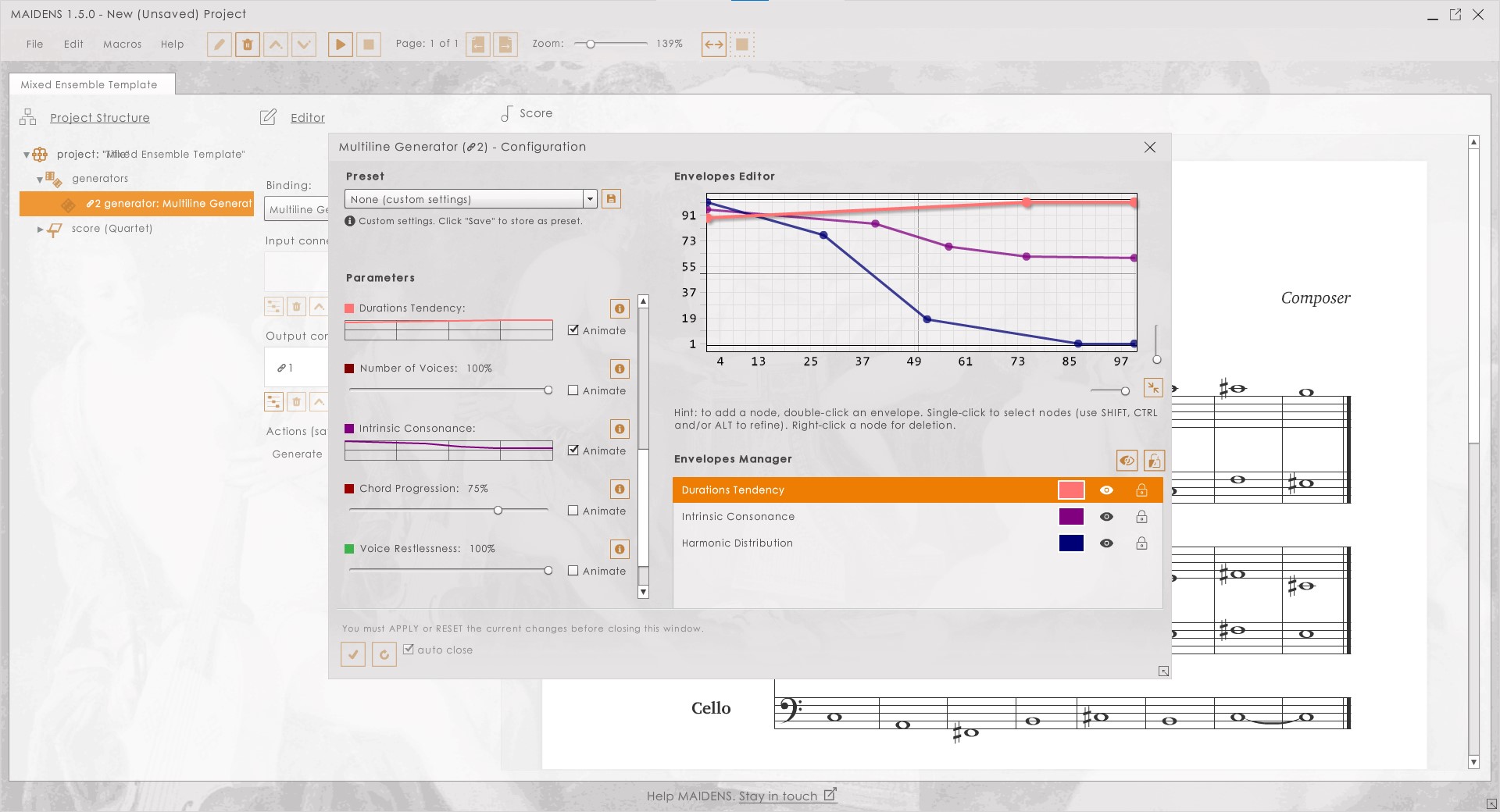-
-
Notifications
You must be signed in to change notification settings - Fork 0
Home
MAIDENS is a piece of software built by Claudius Iacob, a musician and a programmer, as a by-product of his PhD thesis on algorithmic aspects in musical composition. Its primary aim is to enable an educated art music composer to generate — based on programmable algorithms — partial musical structures, which can be intertwined in a composition. This qualifies MAIDENS as a CAAC (or Computer Aided Algorithmic Composition) software program.

The MAIDENS application combines three distinct classes of functionality:
-
musical structures generation: the program produces complete or partial music structures based on configurable algorithms. Other software that tackles this task is, e.g., MAX/MSP, SuperCollider or Csound. As a sidenote, MAIDENS contrasts with all this software by treating the exact algorithms it uses as black boxes, i.e., functional entities end-users never have to touch the inner workings of (and actually couldn't). The most important consequence of this fact is that there is no coding involved in using MAIDENS.
-
music processing: the software operates discrete changes on existing musical material in order to refine or transform it; transposing a bar of music is a common example of such activity. Literally all software providing notation or MIDI editing features also provide some degree of music processing;
-
score notation: despite not being a score notation editor, MAIDENS does provide a minimal set of features that allows the end-user to put together a symbolic music representation, using the western classical notation system (notes on staves). The rationale behind that revolves around two use-cases:
- some generators might need/accept user musical input (e.g., a chords generator might accept a soprano line to harmonize); and
- user might want to make in-situ, minor adjustments to generated material, in order to better evaluate it before deciding whether it is worth exporting for further processing in a full-scale notation program or DAW. Among other software that provide this class of functionality Sibelius, Finale and MuseScore can be mentioned;
Apart from this core set, the application also provides the common, workflow-related features one would expect from a music editing program:
- it saves and opens files to/from its custom format (*.MAID, a binary file format);
- exports the score to MIDI, abc notation or MusicXML;
- renders an audio preview of the score via exporting it to the WAV format;
- produces a (raw) printable score via exporting projects to PDF.
The envisioned use of the software entails creating art music by mixing human composition with computer algorithmic generation and/or processing. It is the software's author belief that such a music making approach can lead to new realms of artistic expression, while improving the overall ease, speed and quality of the process.
- MAIDENS — Machine Aided New Sounds
- The Project Hierarchy
- Project Node
- Generators Node
- Generator Node
- Score Node
- Section Node
- Part Node
- Measure Node
- Voice Node
- Cluster Node
- Note Node
- Introducing Generators
- Getting to Know the User Interface
- Score UI
- Editor UI
- Project UI
- Menu UI
- Toolbar UI
- Notifications UI
- Picker UI
- Navigator UI
- Configuration UI Legacy
- Configuration UI (New)
- Presets Manager
- How to Edit the Score
- Add a Note, Rest or Chord
- Edit or Remove Notes, Rests or Chords
- Add, Edit or Remove Measures
- Add, Edit, or Remove Instruments
- Use Second Voice
- Use Tuplets
- Use Sections
- Use Copy/cut/paste
- Use Undo/Redo
- Use the Macros
- How to Generate Music
- Limitations in 1.5.5
- Prospects